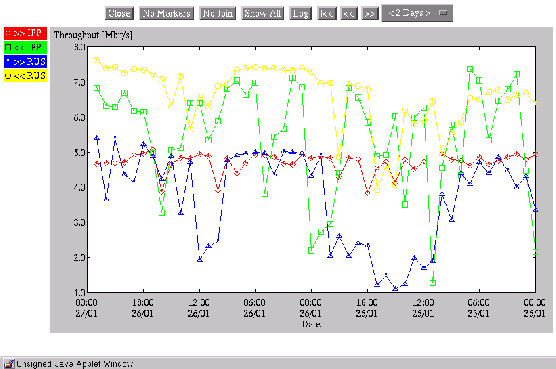


Next: Average workday throughput in
Up: Measurements IPP - FOM - UU
Previous: Introduction
In this subsection the typical data of Wednesday 26/01/2000 and Tuesday
25/01/2000 are presented.
In figure 4 the throughput measurements
between the ZAM host and the SARA and UU-36 hosts
are given. These hosts are selected here, because all have an interface
with a bandwidth of 100 Mbit/s. It is the intension of this plot
to check for the speed of the 100 Mbit/s interface at Jülich.
Figure:
This plot shows the throughput values between the
ZAM host and the SARA and the UU-36
hosts. All these hosts have 100 Mbit/s
interfaces. Typical data from Wednesday 26/01/2000 and
Tuesday 25/01/2000 are presented
here. Show
plot
in real size.
 |
Figure 5 displays the throughput measurements
between the IPP host and the FOM and UU-36 hosts.
Note that the IPP and FOM hosts have 10 Mbit/s
interfaces, in contradiction to the 100 Mbit/s interface of
UU-36. This plot is intended to compare the 10 Mbit/s
interface of IPP with the 100 Mbit/s interface of
ZAM.
Figure:
This plot shows the throughput values between the
IPP host and the FOM and UU-36 hosts.
The first two hosts have 10 Mbit/s interfaces, the
latter has a 100 Mbit/s interface. Typical data from
Wednesday 26/01/2000 and Tuesday 25/01/2000 are presented
here. Show
plot
in real size.
 |
To make a comparison between the two DFN routes to Jülich and
Stuttgart, figure 6 shows the throughput data
between the FOM host and the IPP (Jülich) and
RUS (Stuttgart) hosts. All hosts have 10 Mbit/s
interfaces.
Figure:
This plot displays the throughput values between the
FOM host and the IPP and RUS hosts.
All hosts have 10 Mbit/s interfaces. Typical data
from Wednesday 26/01/2000 and Tuesday 25/01/2000 are
presented
here. Show
plot
in real size.
 |
From these figures the following conclusions can be drawn:
-
- 1.
- In figure 4 we see rather deep daily
performance decreases (12:00 - 18:00) especially in the
connection ZAM - UU-36. The decrease in the
direction ZAM >> UU-36 is deeper and a
bit earlier than in the other direction.
- 2.
- The performance decreases (figure 4) are
less clear found at in the connection ZAM -
UU-36. However, the overall performance of this
connection is much lower. The reason therefore is unclear.
- 3.
- In figure 4 we also see performance lost
during the evening (19:00 - 23:00). Probably due to Internet
browsing from people at home.
- 4.
- In figure 5 the same performance dips
appear as in figure 4, however, due to
the smaller bandwidth of the interfaces they are less
profound.
- 5.
- In figure 5 it also that a higher
throughput can be reached at the connection IPP -
UU-36, than at IPP - FOM, although the
performance dips are deeper and even below the IPP -
FOM connection.
- 6.
- Comparing in figure 6 the connection
FOM << IPP with
FOM << RUS, it appears that the
performance in the connections from Jülich, also found in
the figures 4
and 5 is less profound in the connection
to Stuttgart. However, there is a considerable performance dip
in the connection FOM >> RUS.
- 7.
- From all figures it follows that the throughput from the
FOM to Germany is lower than in the other direction,
while for host UU-36 the reverse is valid.



Next: Average workday throughput in
Up: Measurements IPP - FOM - UU
Previous: Introduction
Hans Blom
2000-02-02



